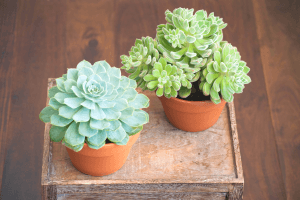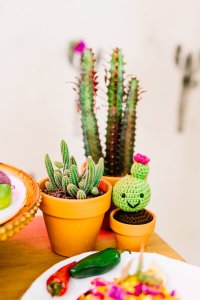Blog
Succulents
Part 3 in our Houseplant Mini-series
Tabletop
Part three of our new mini-series highlighting individual house plants features succulents, probably one of the most misunderstood houseplants.
We’ve all seen the photos. We’ve seen them on products, we’ve seen them in magazines and instagram. Succulents featured in covered terrariums, succulents placed in low light or windowless rooms. Succulents in pots without drainage. The problem is, these situations will most definitely ensure that your beautiful plants will die.
Knowing where succulents grow in the wild can give you a better understanding of how to make them happy in your home. Succulents can be found all over the world. Most are found in sunny dry arid conditions, in deserts and in sandy coastal areas though there are hardy sedums such as our native Sedum ternatum that do well outdoors in winters and some that come from mountainous regions such as the himalayas, but these aren’t the ones you’ll necessarily be growing indoors. That being said, if you want to grow succulents indoors, you will need to have a sunny windowsill or good grow lights positioned very close to the plants.
Succulent Care
Light
Most succulents enjoy full to partial sun. A full five or more hours of morning sun spent right next to a window is ideal for most succulents. Summering them outdoors would need the same care. Strong midday summer sun outdoors may sunburn the leaves of most succulents.
Grow lights can supplement your sun needs. Make sure to purchase one with a lumen rating between 2300 and 9300 which will replicate daylight. The grow lights need to be placed close to the plants. The further the light is away from the foliage the more it dissipates.
Soil
Succulents and Cacti have small root systems compared to the size of the plants. Soil must be well drained, so a mix designed specifically for cacti and succulents is ideal. Adding additional perlite to the mix for larger pots will help with drainage. Also, please do not add rocks to the bottom of your container. From Kathleen Cue, Nebraska Extension Horticulture Educator ”Rocks in the bottom of containers do not contribute to better draining soils and healthier plants. Instead plant roots encounter saturated soils that don’t drain efficiently. It all has to do with something called a perched water table.
Ideally, when we water our containers, or Mother Nature provides rainfall, water percolates through the soil and out the drainage hole below. All the roots get water and the excess drains away. In a container with rocks at the bottom, however, water percolates through the soil and, upon encountering the different layer, the water moves sideways, creating a saturated zone. Water in this saturated zone gets “hung up” on the layer that is different.
And it doesn’t have to be rocks that are placed at the bottom of the pot. ANY layer of difference will contribute towards a perched water table—a different potting mix, sand, pop cans, and golf balls among them.”
Containers
Most succulents prefer a shallow pot as their root systems are quite small. A shallow container with good drainage ensures that the plant’s roots will not stay moist and rot. Terra cotta is a great choice as the containers breathe but shallow bonsai pots are perfectly suited and have great drainage holes and come in a wide variety of colors, sizes and shapes.
Water
Always water the soil and not the plant when watering your succulents indoors. Mold and mildew can become a problem for the leaves of indoor succulents if they are watered. Allow the container to partially dry out about halfway before thoroughly watering. During the growing season, spring through fall, you will need to check your containers more often as a growing plant uses up the moisture in the soil faster than during its dormant period.
Pests
Pests on succulent plants are rare but it does happen. Checking your plants often can help eliminate an infestation. Mealybugs, Aphids and Scale are the most common problems. If an infestation is bad, you might want to consider removing the plant from the home and purchasing a new plant before the infestation affects other plants in the home.
Before treating the plant, move it to an isolated area away from all other plants. Then determine what type of pest is affecting the plant.
Mealybugs. Mealybugs are small soft bodied insects, about 2-3 millimeters long that you’ll probably first notice as white fluff on and around your plant. They can be found anywhere from leaf joints, stems,in the soil, to the lips of the containers. To eliminate a small infestation, dip an ear swab directly into rubbing alcohol and touch the insects. You’ll need to do this every few days for a few weeks. If the infestation is bad, you may need to repot the plant using fresh new cactus soil mix and a fresh clean container. But as was mentioned earlier, if an infestation of any sort is bad, it might be best to destroy the plant and start with a fresh one making sure to thoroughly clean the area where the plant was originally housed.
Aphids. Aphids are very small soft bodied insects. They come in colors such as white, red, brown and black. Usually you notice them by the sooty mold created by the honeydew which the aphids excrete.
Aphids can be easily washed off plants with water and can be controlled indoors with a systemic insecticide labeled for houseplants or an application of insecticidal soap labeled for houseplants. You must take the time to check the label thoroughly to make sure it is safe for your particular plant and pest.
Scale. Scale insects are attracted to the fleshy sap filled leaves of succulents. They drain the plant of the sap causing it to weaken and eventually collapse. Symptoms usually present themselves as the plant would be under extreme stress.
Because of their shells, traditional sprays generally do not work on scale insects. Removing them by hand is tedious but is very effective. Use a fingernail, a toothpick or anything that you can gently pop them off and drop on to a paper towel that you will dispose of. You don’t want to damage the flesh of the succulent. If the scale infestation is bad, then consider disposing of the plant and purchasing a new one and sanitizing the container.
Check back with Modern Foliage next time when we will discover how creative you can be with a Simple Pothos.
Missi Lackas, blog writer for Modern Foliage Designs.
missi@modernfoliage.com



